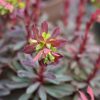Description
Euphorbia amygdaloides ‘Purpurea’, also known as wood spurge, is a stunning perennial plant that adds a pop of color to any garden. The deep purple-green leaves are a standout feature of this plant, which produce clusters of bright chartreuse flowers in the spring. It grows in a clumping habit, and prefers well-drained soil in partial shade to full sun. Wood spurge is a versatile plant that works well in a variety of garden settings, including cottage gardens, rock gardens, and mixed borders. It pairs well with other spring-flowering plants such as tulips and daffodils, as well as with summer-blooming perennials like salvia and echinacea.
Key Facts
- Common Name(s):Wood spurge ‘Purpurea’
- Hardiness:Fully hardy
- How big will I get? Euphorbia amygdaloides ‘Purpurea’ can grow to a height of 1m and a spread of 1m.
- Did You Know That:Euphorbia is one of the largest genera of flowering plants with over 2000 members?
Plant Calendar
A rough guide to how this plant will change through the year.
| Jan | Feb | Mar | Apr | May | June | July | Aug | Sept | Oct | Nov | Dec | |
| Flowering Time |   |
  |
  |
  |
||||||||
| Foliage Colour |  |
 |
 |
 |
 |
 |
 |
 |
 |
 |
 |
 |
| J | F | M | A | M | J | J | A | S | O | N | D |
  |
  |
  |
  |
||||||||
 |
 |
 |
 |
 |
 |
 |
 |
 |
 |
 |
 |
Care Guide

Soil Requirements
Euphorbia amygdaloides ‘Purpurea’ is a versatile plant and can cope with wet or drier soils, but prefers there to be decent drainage. This plant can grow in soil with a wide range of pH levels, it is not picky about the pH level of the soil.

Best Position
Euphorbia amygdaloides ‘Purpurea’ can handle either an exposed or a sheltered position and is a very versatile plant that can cope with full shade, partial shade, or full sun.

Maintenance
Euphorbia amygdaloides ‘Purpurea’ should be cut back in the autumn will promote growth the following year by redirecting energy from seed production and foliage maintenance to root growth.

Pest, Diseases and Wildlife
Euphorbia amygdaloides ‘Purpurea’ can have problems with aphids, it can be vulnerable to certain diseases such as grey moulds. It is also known to attract beneficial insects. It is toxic to cats, dogs, horses and people.





